Your cart is currently empty!
Tag: learning Japanese
-
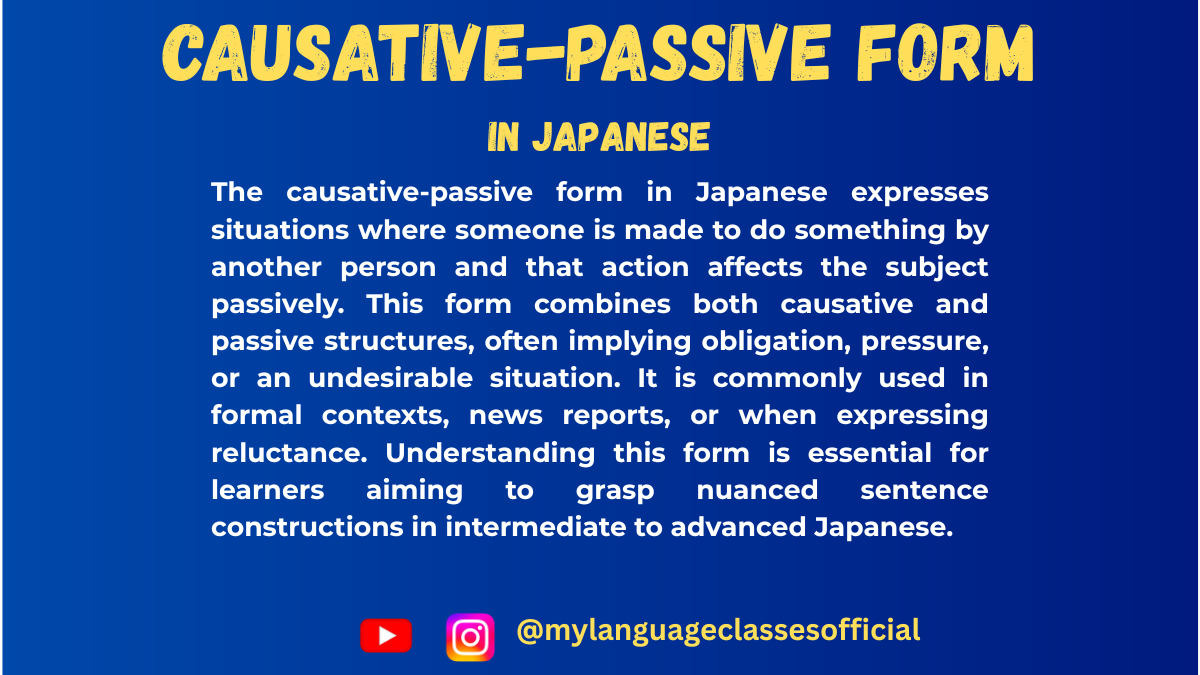
Causative-Passive Form of verbs in Japanese | My Language Classes
Causative-Passive Form in Japanese
The causative-passive form (使役受身, shieki ukemi) in Japanese is an important grammatical structure that conveys a sense of being forced or made to do something against one’s will. This form is frequently used in formal speech, written language, and storytelling.
Formation of Causative-Passive Verbs
To form the causative-passive form, we first conjugate the verb into its causative form and then change it into its passive form.
Group 1 (Ichidan) Verbs
- Convert the verb to its causative form:
- Drop る and add させる (for positive causative)
- Convert the causative form to its passive form:
- Drop る and add られる
Example:
- 食べる (たべる, taberu) → 食べさせる (たべさせる, tabesaseru) → 食べさせられる (たべさせられる, tabesaserareru)
Group 2 (Godan) Verbs
- Convert the verb to its causative form:
- Change the u sound to a and add せる
- Convert the causative form to its passive form:
- Change せる to せられる or される
Example:
- 書く (かく, kaku) → 書かせる (かかせる, kakaseru) → 書かせられる (かかせられる, kakaserareru)
Group 3 (Irregular) Verbs
- する → させる → させられる
- くる → こさせる → こさせられる
Usage of the Causative-Passive Form
The causative-passive form is primarily used in the following situations:
- Expressing Forced Action
- “I was made to do something.”
- Indicating an Unwanted Situation
- “I ended up in an unfavorable situation.”
- In Formal Writing & Passive Expressions
- Commonly used in news articles, literature, and business settings.
- Indirect Authority or Control
- Used when talking about school, work, or hierarchical relationships.
- Apologizing or Explaining a Difficult Situation
- “I was put in a tough spot.”
List of Causative-Passive Verbs with Examples
Verb Causative-Passive Form Example Sentence 1 Romaji English Meaning Example Sentence 2 Romaji English Meaning 書く (kaku) 書かせられる (kakaserareru) 先生に作文を書かせられた。 Sensei ni sakubun o kakaserareta. I was forced to write an essay by the teacher. 上司にレポートを書かせられた。 Joushi ni repooto o kakaserareta. I was made to write a report by my boss. 食べる (taberu) 食べさせられる (tabesaserareru) 嫌いな野菜を食べさせられた。 Kirai na yasai o tabesaserareta. I was made to eat vegetables I dislike. 子供のころ、嫌いな魚を食べさせられた。 Kodomo no koro, kirai na sakana o tabesaserareta. When I was a child, I was made to eat fish I disliked. 話す (hanasu) 話させられる (hanasaserareru) 上司に長いスピーチを話させられた。 Joushi ni nagai supiichi o hanasaserareta. I was made to give a long speech by my boss. 友達に嘘を話させられた。 Tomodachi ni uso o hanasaserareta. I was forced to tell a lie by my friend. 読む (yomu) 読まさせられる (yomasaserareru) 先生に長い本を読まさせられた。 Sensei ni nagai hon o yomasaserareta. I was forced to read a long book by the teacher. 上司に新聞を読まさせられた。 Joushi ni shinbun o yomasaserareta. I was made to read the newspaper by my boss. 行く (iku) 行かさせられる (ikasaserareru) 先生に学校に行かさせられた。 Sensei ni gakkou ni ikasaserareta. I was made to go to school by the teacher. 父に病院に行かさせられた。 Chichi ni byouin ni ikasaserareta. I was forced to go to the hospital by my father. More Example Sentences
- 先生に漢字を100回書かせられた。
Sensei ni kanji o hyakkai kakaserareta.
I was forced to write kanji 100 times by the teacher. - 母に部屋を掃除させられた。
Haha ni heya o souji saserareta.
I was made to clean my room by my mother. - 部長に遅くまで働かさせられた。 Buchou ni osoku made hatarakasaserareta. I was made to work late by my manager.
- 先生に難しい問題を解かさせられた。 Sensei ni muzukashii mondai o tokasaserareta. I was forced to solve a difficult problem by the teacher.
- 親に謝らさせられた。 Oya ni ayamarasaserareta. I was made to apologize by my parents.
Conclusion
The causative-passive form is a useful grammatical structure for expressing situations where someone is forced to act against their will. While it is more common in written and formal contexts, mastering this form will greatly enhance your Japanese comprehension and expression skills. Keep practicing with different verbs and real-life situations to fully grasp the nuances of this construction!
If you enjoyed this lesson, be sure to check out more posts like this on my blog at My Language Classes. Don’t forget to subscribe my YouTube channel and follow me on Instagram for the latest language learning tips and lessons. Leave a comment below to share your thoughts, or ask any questions you have about nouns.
Happy learning! 😊
- Convert the verb to its causative form:
-
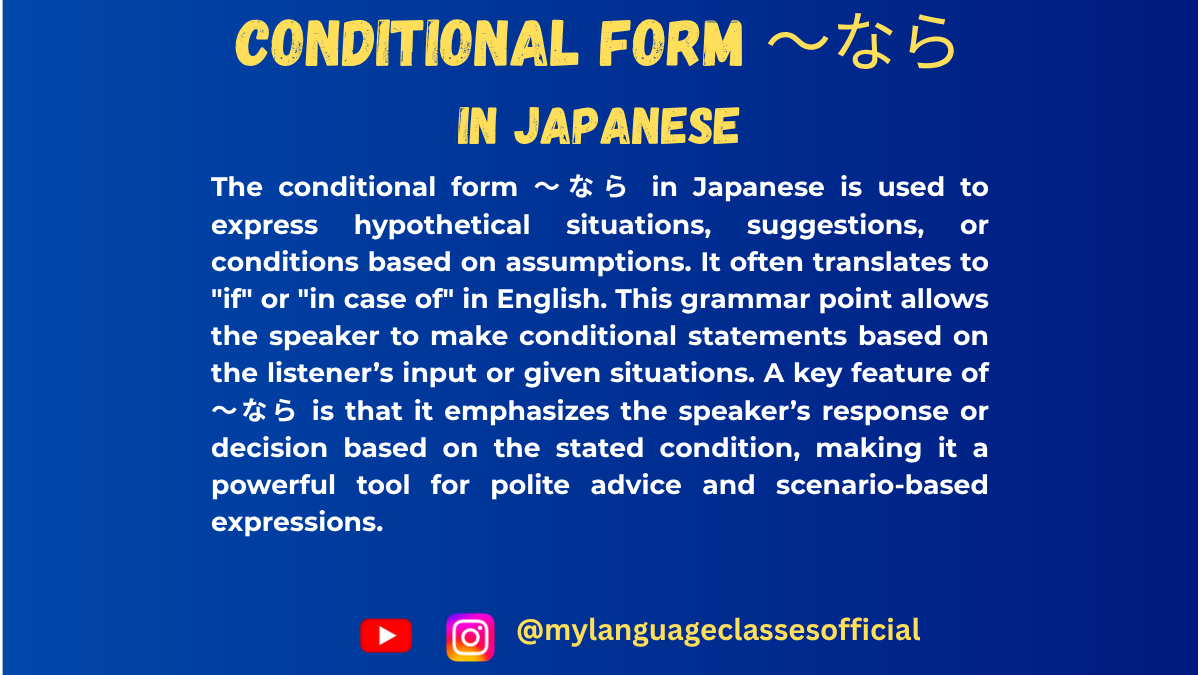
Using 〜なら for hypothetical situations | My Language Classes
〜なら: Expressing “If” or “As for” in Japanese
In Japanese, 〜なら is a versatile grammar structure often used to express conditionality (“if”) or to provide contextual emphasis (“as for”). This blog post will explore its usage in various contexts and provide a comprehensive list of situations where 〜なら is applicable.
What is 〜なら?
The particle なら is derived from the verb 成る (なる), which means “to become.” In grammar, it functions as a conditional marker or a topic-related particle depending on the context. It is commonly attached to the plain form of verbs, nouns, or adjectives.
Usage of 〜なら
1. Conditional “If”
- Meaning: Expresses a hypothetical or conditional situation.
- Structure:
Clause A (plain form) + なら, Clause B
Clause B often represents the speaker’s judgment, advice, or consequence.
Examples:
- 日本に行くなら、富士山を見たほうがいいですよ。
(Nihon ni iku nara, Fujisan o mita hō ga ii desu yo.)
If you’re going to Japan, you should see Mt. Fuji. - 雨が降るなら、外出しないほうがいいです。
(Ame ga furu nara, gaishutsu shinai hō ga ii desu.)
If it rains, you shouldn’t go out.
2. Topic-Based “As for”
- Meaning: Indicates that a specific topic is being addressed in response to a preceding statement or question.
- Structure:
Noun + なら
Examples:
- 映画なら、コメディが一番好きです。
(Eiga nara, komedi ga ichiban suki desu.)
As for movies, I like comedies the best. - この本なら、もう読んだことがあります。
(Kono hon nara, mō yonda koto ga arimasu.)
As for this book, I’ve already read it.
3. Contrasting Ideas
- Meaning: Suggests a contrast between two different ideas or topics.
- Structure:
Noun/Adjective/Verb + なら
Examples:
- 英語なら話せますが、フランス語は話せません。
(Eigo nara hanasemasu ga, Furansugo wa hanasemasen.)
If it’s English, I can speak it, but I can’t speak French. - 安いなら買いますが、高いなら買いません。
(Yasui nara kaimasu ga, takai nara kaimasen.)
If it’s cheap, I’ll buy it, but if it’s expensive, I won’t.
4. Hypothetical Suggestions
- Meaning: Used when giving suggestions or advice based on hypothetical conditions.
- Structure:
Clause + なら
Examples:
- 東京に行くなら、スカイツリーを訪れるべきです。
(Tōkyō ni iku nara, Sukaitsurī o otozureru beki desu.)
If you’re visiting Tokyo, you should check out the Skytree. - 勉強するなら、早めに始めたほうがいいですよ。
(Benkyō suru nara, hayame ni hajimeta hō ga ii desu yo.)
If you’re going to study, it’s better to start early.
5. Clarifications or Conditions
- Meaning: Used when responding to a condition or clarifying information.
- Structure:
Noun + なら
Examples:
- 山田さんなら、もう帰りましたよ。
(Yamada-san nara, mō kaerimashita yo.)
If you’re talking about Yamada-san, he’s already gone home. - 駅なら、この道をまっすぐ行けば着きます。
(Eki nara, kono michi o massugu ikeba tsukimasu.)
If you mean the station, go straight down this road.
When to Use 〜なら?
Here is a quick checklist of situations where 〜なら is appropriate:
- Making a Hypothetical Conditional Statement:
“If you’re going to X, then Y.” - Responding to Questions or Comments with Context:
“As for X, Y applies.” - Contrasting Two Scenarios or Topics:
“If X is true, Y. But if not, Z.” - Providing Advice Based on Hypothetical Situations:
“If you’re considering X, then Y is a good idea.” - Clarifying or Confirming a Specific Topic:
“If you’re talking about X, then Y.”
Tips for Using 〜なら
- Be Contextual: 〜なら thrives on context. Make sure the listener understands the implied condition or topic.
- Be Specific: Use it to address clear contrasts or hypothetical situations, avoiding vague statements.
- Practice Intonation: When using 〜なら in spoken Japanese, emphasize the conditional tone to make your intent clear.
By mastering 〜なら, you’ll find yourself able to express conditions, offer advice, and clarify topics more effectively in Japanese. Practice by creating your own sentences in real-life scenarios!
If you enjoyed this lesson, be sure to check out more posts like this on my blog at My Language Classes. Don’t forget to subscribe my YouTube channel and follow me on Instagram for the latest language learning tips and lessons. Leave a comment below to share your thoughts, or ask any questions you have about nouns.
Happy learning! 😊
-
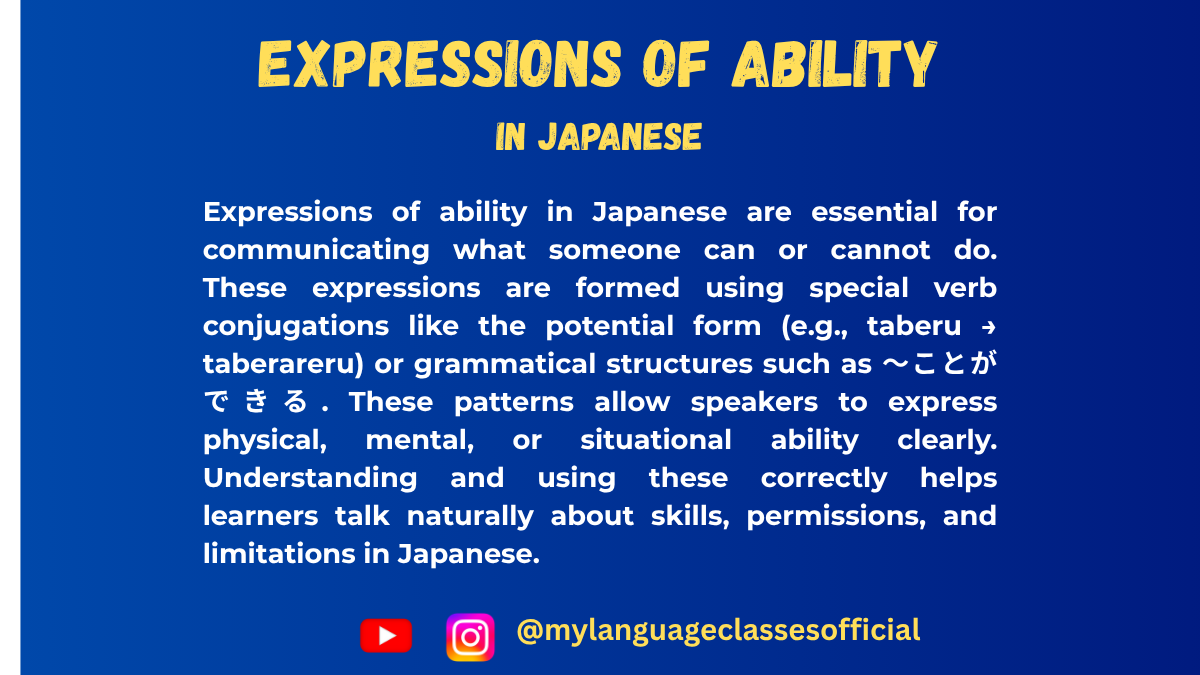
Understanding Ability in Japanese | My Language Classes
Mastering the Expressions of Ability in Japanese
When learning Japanese, expressing ability—your capacity to “do” something—is a crucial skill. In this post, we’ll delve into one of the most common ways to express “can” in Japanese: using ことができる (koto ga dekiru). Along the way, we’ll also explore the potential form of verbs, explaining what it is, how it’s formed, and when to use it. Let’s get started!
Understanding ことができる
The phrase ことができる translates roughly to “can do” or “be able to do.” It’s a versatile structure that allows you to express ability in relation to a wide range of actions. Here’s a breakdown of its components:
- こと: A nominalizer that turns verbs into nouns. For instance, “to speak” (話す, hanasu) becomes “the act of speaking” (話すこと, hanasu koto).
- が: The particle marking the subject of the ability.
- できる: The verb meaning “can do” or “to be able to do.”
Basic Formula:
Verb (Dictionary Form) + ことができる
Examples:
- 日本語を話すことができる
(Nihongo o hanasu koto ga dekiru)
“I can speak Japanese.” - ピアノを弾くことができる
(Piano o hiku koto ga dekiru)
“I can play the piano.” - 友達と旅行することができる
(Tomodachi to ryokou suru koto ga dekiru)
“I can travel with my friends.”
Using できる as a Standalone Verb
Did you notice that できる itself can also stand alone? It translates simply as “can do” and is often paired with a noun:
- テニスができる
(Tenisu ga dekiru)
“I can play tennis.” - 宿題ができる
(Shukudai ga dekiru)
“I can do homework.”
This usage avoids the ことが entirely, but the meaning remains similar.
What is the Potential Form?
The potential form of a verb is another way to express “can” or “ability to do something” in Japanese. Unlike ことができる, the potential form is built directly into the verb itself. It’s widely used in casual speech due to its simplicity and brevity.
When to Use the Potential Form
The potential form is ideal for situations where:
- Informality is key: It’s more conversational than ことができる.
- Directness is preferred: Instead of a multi-word structure, the potential form is compact and to the point.
How to Form the Potential Form
The way you form the potential form depends on the type of verb:
1. Group 1 Verbs (U-verbs)
For U-verbs, change the final -u sound of the dictionary form to its corresponding -eru sound.
Example:
- 話す (hanasu, “to speak”) → 話せる (hanaseru, “can speak”)
- 書く (kaku, “to write”) → 書ける (kakeru, “can write”)
- 泳ぐ (oyogu, “to swim”) → 泳げる (oyogeru, “can swim”)
2. Group 2 Verbs (Ru-verbs)
For Ru-verbs, simply replace the final -ru with -rareru.
Example:
- 食べる (taberu, “to eat”) → 食べられる (taberareru, “can eat”)
- 見る (miru, “to see”) → 見られる (mirareru, “can see”)
3. Irregular Verbs
There are only two irregular verbs to remember:
- する (“to do”) → できる (“can do”)
- 来る (kuru, “to come”) → 来られる (korareru, “can come”)
Examples of the Potential Form:
- 日本語が話せる
(Nihongo ga hanaseru)
“I can speak Japanese.” - ピアノが弾ける
(Piano ga hikeru)
“I can play the piano.” - 友達と旅行できる
(Tomodachi to ryokou dekiru)
“I can travel with my friends.”
Potential Form vs. ことができる
While both methods express ability, they have distinct nuances:
- ことができる: More formal and suitable for writing or polite contexts.
- Example: 日本語を話すことができる
- Potential Form: Shorter and more conversational.
- Example: 日本語が話せる
The Negative Forms
For both ことができる and the potential form, negation is straightforward:
- ことができない: “Cannot do.”
- Example: 日本語を話すことができない
- Potential form (negative): Replace the final -eru or -rareru with -enai or -rarenai.
- Example: 日本語が話せない
Politeness Levels
Japanese offers ways to adjust politeness. Here’s how to modify each form:
- ことができます: Polite version of ことができる.
- Potential Form (Polite): Add -ます to the potential form.
- Example: 話せます (hanasemasu, “can speak”).
Practice Makes Perfect
Let’s end with some practice sentences. Try translating these into Japanese:
- “I can read kanji.”
- “I cannot eat sushi.”
- “I can go to Japan next year.”
(Answers: 1. 漢字を読むことができる / 漢字が読める, 2. 寿司を食べることができない / 寿司が食べられない, 3. 来年日本に行くことができる / 来年日本に行ける)
Final Thoughts
Understanding how to use ことができる and the potential form unlocks a world of possibilities for expressing your abilities in Japanese. Whether you’re aiming for formal precision or casual brevity, practicing these structures will help you sound more natural and confident.
Have questions or want to share your examples? Comment below! 😊
If you enjoyed this lesson, be sure to check out more posts like this on my blog at My Language Classes. Don’t forget to subscribe my YouTube channel and follow me on Instagram for the latest language learning tips and lessons. Leave a comment below to share your thoughts, or ask any questions you have about nouns.
Happy learning! 😊
-
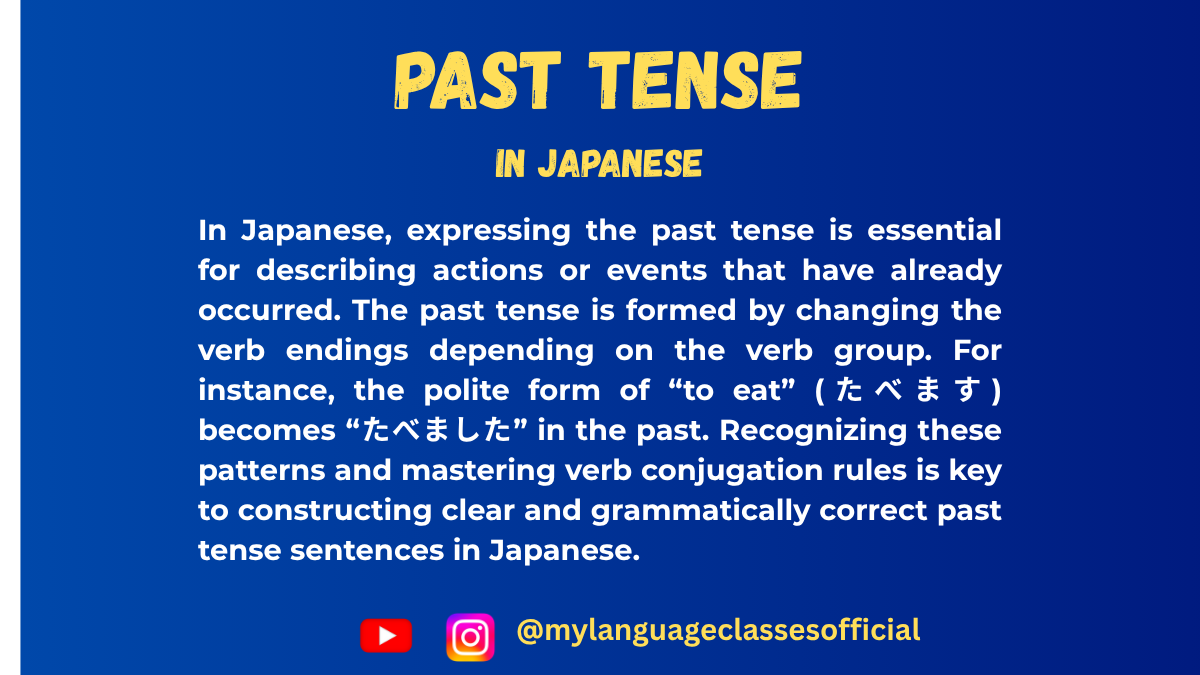
Mastering the Past Tense in Japanese | My Language Classes
Mastering Japanese Past Tense
If you’re learning Japanese, understanding how to express actions in the past is essential for communication. Japanese verbs are logically structured, and once you master their conjugations, you’ll be ready to share stories, describe events, and more.
In this post, we’ll focus on the positive past tense and the negative past tense, with step-by-step explanations for verbs ending in different sounds (like -ku, -ru, -mu, and more). By the end, you’ll feel confident using these forms in your Japanese conversations.
The Basics of Japanese Past Tense
Japanese verbs don’t conjugate based on the subject, so there’s no distinction between “I ate” and “she ate.” The conjugation only reflects tense (past, present, etc.) and polarity (positive or negative).
The two forms we’ll focus on are:
- Positive Past Tense – For actions that happened.
- Negative Past Tense – For actions that didn’t happen.
1. Positive Past Tense: 食べた (tabeta) – “ate”
The positive past tense is based on the た-form of the verb. To create it, we modify the ending of the verb according to its type.
Group 1 (U-verbs)
For U-verbs, the conjugation depends on the final -u sound. Each sound (-ku, -ru, -mu, etc.) follows a specific rule:
Ending Change Example -う (u) Replace う with った 会う (au, “to meet”) → 会った (atta, “met”) -つ (tsu) Replace つ with った 待つ (matsu, “to wait”) → 待った (matta, “waited”) -る (ru) Replace る with った 走る (hashiru, “to run”) → 走った (hashitta, “ran”) -む (mu) Replace む with んだ 飲む (nomu, “to drink”) → 飲んだ (nonda, “drank”) -ぶ (bu) Replace ぶ with んだ 遊ぶ (asobu, “to play”) → 遊んだ (asonda, “played”) -ぬ (nu) Replace ぬ with んだ 死ぬ (shinu, “to die”) → 死んだ (shinda, “died”) -く (ku) Replace く with いた 書く (kaku, “to write”) → 書いた (kaita, “wrote”) -ぐ (gu) Replace ぐ with いだ 泳ぐ (oyogu, “to swim”) → 泳いだ (oyoida, “swam”) -す (su) Replace す with した 話す (hanasu, “to speak”) → 話した (hanashita, “spoke”) Examples:
- 待つ → 待った (matsu → matta): waited
- 書く → 書いた (kaku → kaita): wrote
- 泳ぐ → 泳いだ (oyogu → oyoida): swam
- 遊ぶ → 遊んだ (asobu → asonda): played
Group 2 (RU-verbs)
For RU-verbs, simply drop the る and add た.
Examples:
- 食べる (taberu, “to eat”) → 食べた (tabeta, “ate”)
- 見る (miru, “to see”) → 見た (mita, “saw”)
Irregular Verbs
There are two irregular verbs in Japanese with unique conjugations:
- する (suru, “to do”) → した (shita, “did”)
- 来る (kuru, “to come”) → 来た (kita, “came”)
2. Negative Past Tense: 食べなかった (tabenakatta) – “did not eat”
To express that something did not happen, we use the negative past tense, which builds off the ない-form of the verb.
How to Form the Negative Past Tense
- Convert the verb to its ない-form (present negative).
- Replace ない with なかった.
Group 1 (U-verbs)
The process for creating the ない-form depends on the ending of the verb:
- Change the final -u to its corresponding -a sound, then add ない.
Example: 飲む (nomu, “to drink”) → 飲まない (nomanai, “do not drink”). - Finally, replace ない with なかった for the past tense: 飲まなかった (nomanakatta, “did not drink”).
Examples:
- 書く (kaku, “to write”) → 書かない → 書かなかった (kakanakatta, “did not write”)
- 泳ぐ (oyogu, “to swim”) → 泳がない → 泳がなかった (oyoganakatta, “did not swim”)
- 話す (hanasu, “to speak”) → 話さない → 話さなかった (hanasanakatta, “did not speak”)
Group 2 (RU-verbs)
For RU-verbs, simply drop る and add ない, then conjugate to なかった.
Examples:
- 食べる → 食べない → 食べなかった (taberu → tabenai → tabenakatta): did not eat
- 見る → 見ない → 見なかった (miru → minai → minakatta): did not see
Irregular Verbs
The two irregular verbs follow special patterns:
- する → しない → しなかった (suru → shinai → shinakatta): did not do
- 来る → 来ない → 来なかった (kuru → konai → konakatta): did not come
Examples in Context
Positive Past Tense
- 昨日、本を読んだ。
(Kinō, hon o yonda.)
I read a book yesterday. - 友達に会った。
(Tomodachi ni atta.)
I met a friend.
Negative Past Tense
- 昨日、本を読まなかった。
(Kinō, hon o yomanakatta.)
I didn’t read a book yesterday. - 友達に会わなかった。
(Tomodachi ni awanakatta.)
I didn’t meet a friend.
Tips for Mastery
- Group Drill Practice: Practice conjugating verbs in groups based on their endings (-ku, -su, -mu, etc.) to build muscle memory.
- Daily Use: Write about your day using past tense. Did you eat? Watch a movie? Think about what you didn’t do as well.
- Flashcards: Use flashcards for common verbs in their dictionary, positive past, and negative past forms.
Understanding Japanese past tense empowers you to share your experiences and engage in deeper conversations. With regular practice, you’ll master these forms in no time. がんばって (Ganbatte, “Good luck!”)!
If you enjoyed this lesson, be sure to check out more posts like this on my blog at My Language Classes. Don’t forget to subscribe my YouTube channel and follow me on Instagram for the latest language learning tips and lessons. Leave a comment below to share your thoughts, or ask any questions you have about nouns.
Happy learning! 😊
-
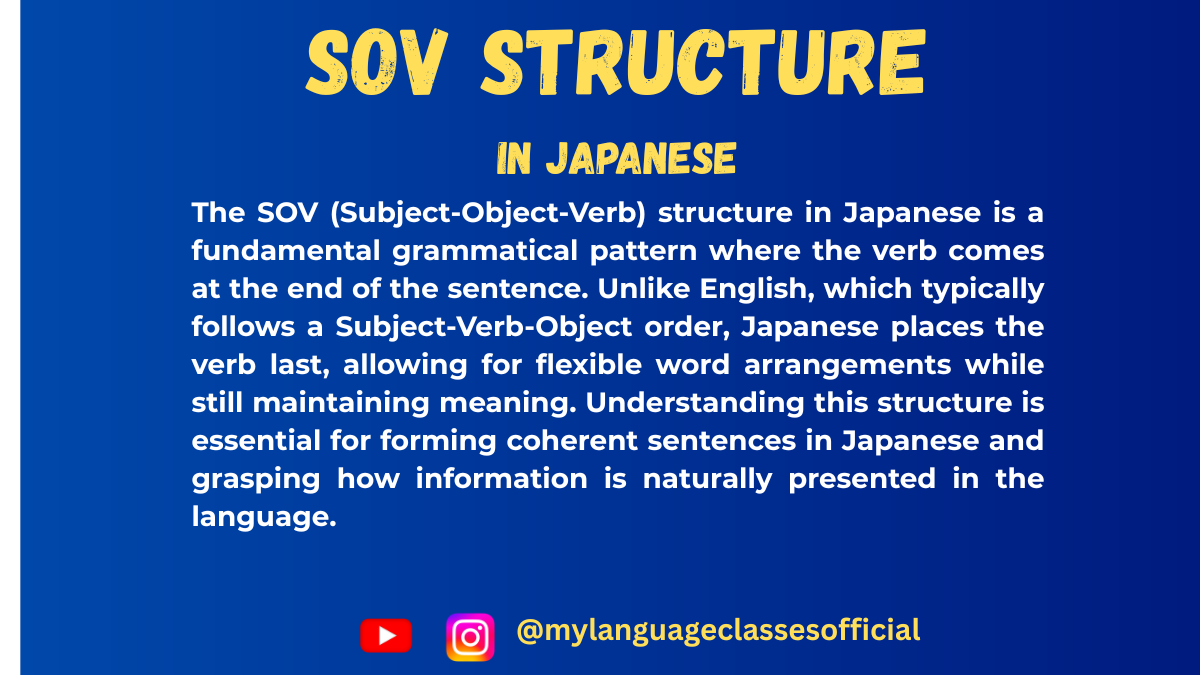
Understanding SOV in Japanese | My Language Classes
Understanding Japanese SOV Structure: A Beginner’s Guide
こんにちは (Konnichiwa)! If you’re embarking on the exciting journey of learning Japanese, understanding its basic sentence structure is a critical first step. Unlike English and many other languages, Japanese follows a unique Subject-Object-Verb (SOV) order. This foundational difference might seem challenging at first, but with some practice and examples, it becomes a powerful tool in expressing your thoughts in Japanese.
Let’s break it down step-by-step.
What is SOV?
In English, we typically structure sentences as Subject-Verb-Object (SVO):
- English (SVO): I eat sushi.
In Japanese, however, the order is Subject-Object-Verb:
- Japanese (SOV): 私は寿司を食べます。
(Watashi wa sushi o tabemasu.)
Literal Translation: I sushi eat.
The verb always comes at the end of the sentence in Japanese. This rule applies to both simple and complex sentences.
Key Components of a Basic Sentence
To better understand the SOV structure, let’s dissect the parts of a Japanese sentence:
- Subject (主語, Shugo): The doer of the action. Often marked with the particle は (wa) or が (ga).
- Object (目的語, Mokutekigo): The receiver of the action. Typically marked with the particle を (o).
- Verb (動詞, Doushi): The action or state. It always concludes the sentence.
Examples of SOV Sentences
Simple Sentence
- Japanese: 猫は魚を食べます。
(Neko wa sakana o tabemasu.)
English: The cat eats fish.
With Additional Information
- Japanese: 友達は公園で遊びます。
(Tomodachi wa kouen de asobimasu.)
English: My friend plays at the park.
Notice that even with additional details like “at the park,” the verb remains at the end.
Question Form
- Japanese: あなたは日本語を勉強しますか?
(Anata wa Nihongo o benkyou shimasu ka?)
English: Do you study Japanese?
The verb 勉強します (benkyou shimasu) still comes at the end, and the question particle か (ka) is added.
Particles: The Glue of Japanese Sentences
Japanese relies heavily on particles to clarify the relationships between words. In SOV sentences, these particles are crucial:
- は (wa): Marks the topic (similar to the subject in simple sentences).
- を (o): Marks the direct object.
- に (ni): Indicates direction or purpose.
- で (de): Indicates the location of an action.
Example with Multiple Particles:
- Japanese: 私は図書館で本を読みます。
(Watashi wa toshokan de hon o yomimasu.)
English: I read a book at the library.
Particles like で and を guide the sentence while the verb 読みます (yomimasu) finishes it.
Why SOV Matters in Japanese
Understanding and mastering the SOV structure unlocks your ability to:
- Create Grammatically Correct Sentences: No matter how complex your thoughts, putting the verb at the end ensures clarity.
- Comprehend Native Speakers: Japanese media, conversations, and writing rely on this structure.
- Build Confidence in Speaking and Writing: With SOV as your foundation, you’ll tackle more advanced grammar with ease.
Tips to Practice SOV Structure
- Use Flashcards: Write the Subject, Object, and Verb separately, then rearrange them into sentences.
- Practice with Simple Sentences: Start with daily actions like eating, reading, or walking.
- Listen and Repeat: Watch Japanese shows or listen to audio clips. Mimic the SOV patterns you hear.
- Write Your Thoughts in Japanese: Journaling in Japanese helps reinforce proper structure.
Final Thoughts
The SOV structure might feel unfamiliar at first, but it’s the foundation of Japanese communication. By embracing this structure early on, you’re setting yourself up for success as you delve deeper into the language.
Remember, practice makes perfect! Try creating your own sentences and share them in the comments. I’d be happy to help correct or guide you.
頑張ってください! (Ganbatte kudasai! – Good luck!)
If you enjoyed this lesson, be sure to check out more posts like this on my blog at My Language Classes. Don’t forget to subscribe my YouTube channel and follow me on Instagram for the latest language learning tips and lessons. Leave a comment below to share your thoughts, or ask any questions you have about nouns.
Happy learning! 😊

